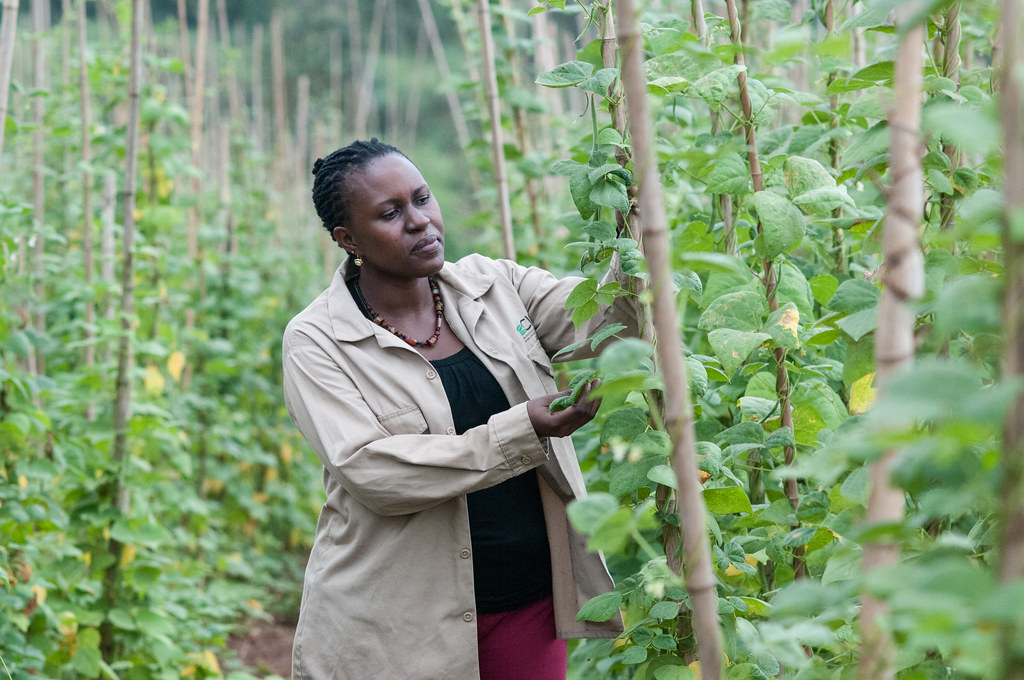In the dry afternoon breeze, Clare Mukankusi pulls on a light khaki lab coat. The 18 acre plot at Kawanda, part of Uganda’s National Agricultural Research Organization, is remote and quite. She shares a few words with one of the field technicians, laughing as she paces slowly though densely packed green beans winding up tall wooden stakes.
A refuge of biodiversity, this plot is where bean seeds, saved and preserved from all over Africa, are prepared for safe keeping in the genebank at Kawanda – Africa’s largest genebank for beans. The plot, carefully tended by more than ten dedicated field staff, is where bean lines, or “families” with specific traits – like drought resilience, disease resistance or high iron – are cultivated, evaluated, and finally multiplied for farmers, if they pass a gamut of tests.

A mother of three, Clare smiles as she delves into her passion for beans. “I’ve always wanted to be a scientist. I wanted to be a medical doctor, I just love biological sciences. Now I’m a doctor – but for plants – a plant doctor. Actually that’s what my kids call me,” she says, laughing.
As one of only two breeders in Africa regulating the flow of beans in and out of the continent’s biggest bean genebank, a lot rests on her shoulders.
“I knew studying beans would be a way for me to reach the poorest in Africa. Beans are so important – they have been known as a poor man’s meat for a long time. Whatever I do here will eventually get to these people – to improve livelihoods, nutrition, incomes.


“Even a woman with a very small piece of land will grow beans,” she continues. “For a long time, they’ve been considered a woman’s crop: they are food, and women are usually responsible for putting food on the table. Beans are the most traded food crop in East Africa. Women rely on beans for income – they are the main source of cash for women, so we want to ensure that they benefit,” she says.
As a member of the Pan-Africa Bean Research Alliance (PABRA), Africa’s largest network of bean researchers spanning more than 30 countries, safeguarding beans and tackling a myriad of challenges in the bean trade – she can reach a lot of women.
With ten countries under her jurisdiction, she’s directly responsible for seed collected from places where beans are not only a vital food, but they are also in danger of becoming lost.
For example, the Seeds of Hope program was initiated before Clare joined CIAT, but Clare found the seeds on the shelves of the store room and they were kept safe. When peace was restored, Rwanda’s beans were sent back – with a back-up copy kept in the Kawanda genebank.
“That’s how Rwanda remains a center of diversity for beans in Africa,” she notes. Researchers estimate that rescue operation saved Rwanda’s breeding programs around 20 years of work already done to improve high-iron beans.

“As breeders, we need diversity to make progress,” she explains. If we don’t keep different breeding lines with different characteristics, we risk losing them forever. If one bean varieties in the field behind me dies because of drought, we would never know what it could have been good for. It may not perform well now – but it might be good for something else in the future.”
That’s why the 3,000 plus bean collection from across Africa, and CIAT’s headquarters in Colombia, safe at the Kawanda genebank, is such a precious resource.
“Our national partners ask us for seed to tackle particular challenges they are facing at that time, but the challenges change. As well as being nutritious and profitable, we need the beans to tackle drought, low soil fertility, diseases, pests and iron and zinc deficiency,” she explains.

Throughout her research, Clare has worked with farmers to preserve beans and ensure they can provide vital genetics to overcome future challenges. “It takes time for farmers to accept new varieties. But when they are hit by extreme weather conditions, they do make choices and trade-offs,” she says.
By preserving and making different kinds of beans available to farmers in Uganda and throughout Africa, Clare and her team maintain precious genetic diversity in the genebank at Kawanda, so that future generations can reap the benefits for many years to come.

